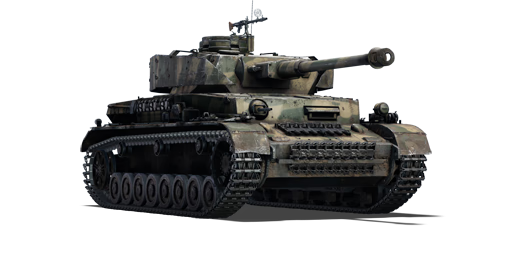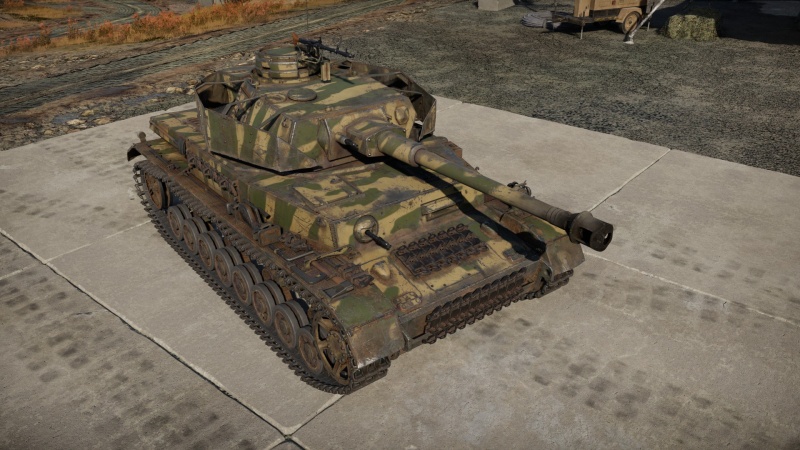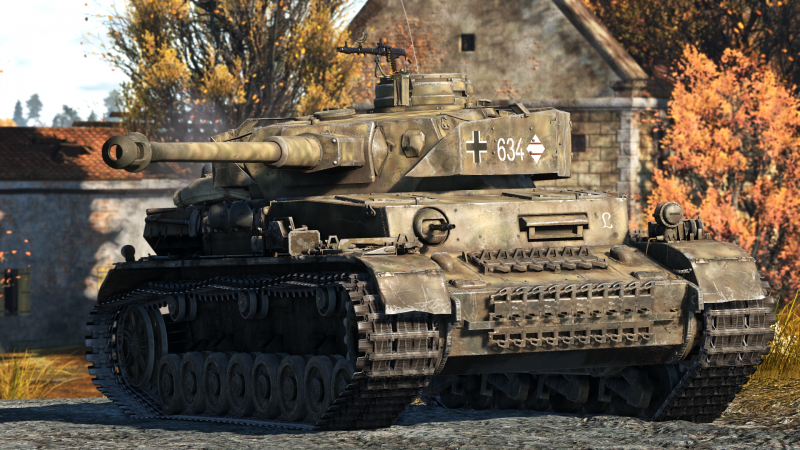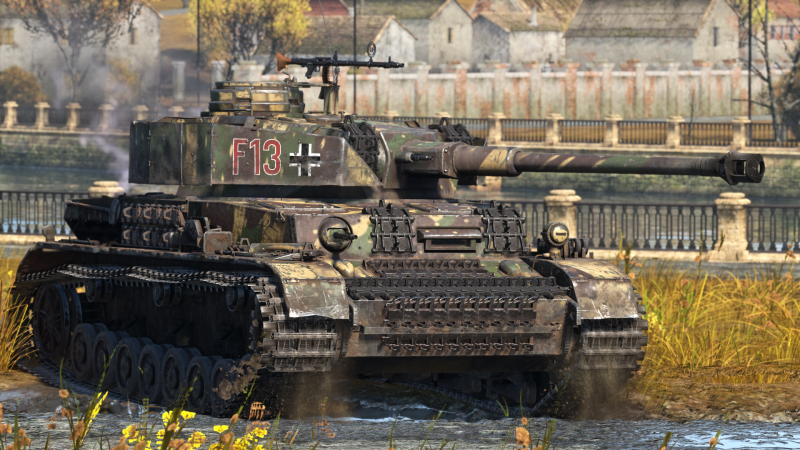Difference between revisions of "Pz.IV J"
m (→Survivability and armour) (Tag: Visual edit) |
m (Grammar) (Tag: Visual edit) |
||
| (8 intermediate revisions by 5 users not shown) | |||
| Line 11: | Line 11: | ||
== Description == | == Description == | ||
<!-- ''In the description, the first part should be about the history of the creation and combat usage of the vehicle, as well as its key features. In the second part, tell the reader about the ground vehicle in the game. Insert a screenshot of the vehicle, so that if the novice player does not remember the vehicle by name, he will immediately understand what kind of vehicle the article is talking about.'' --> | <!-- ''In the description, the first part should be about the history of the creation and combat usage of the vehicle, as well as its key features. In the second part, tell the reader about the ground vehicle in the game. Insert a screenshot of the vehicle, so that if the novice player does not remember the vehicle by name, he will immediately understand what kind of vehicle the article is talking about.'' --> | ||
| − | The ''' | + | The '''Panzerkampfwagen IV Ausführung J''' ([[Abbreviations#.28DE.29_Sd.Kfz._Index|Sd.Kfz. Index:]] '''Sd.Kfz. 161/2''') is the ninth and the last variant of the [[Pz.IV (Family)|Panzerkampfwagen IV medium tank family]]. It was manufactured solely at the Nibelungenwerk factory in Sankt Valentin, northern Austria, from January 1944 to the end of April 1945. This variant was distinguished by numerous simplifications made to prior variants to accelerate production and conserve valuable materials. Instead of making further advancements, the Panzer IV J variant is a retrograde development from the previous [[Pz.IV H|Panzer IV H variant]]. This last variant included replacing the single-speed turret traverse electric power drive with a two-gear manual traverse, with the extra space used for fuel storage. This was a last-ditch effort to increase Panzer IV production rate and compensate for tank losses. |
| − | + | Introduced in [[Update 1.43]], the Panzer IV J variant is a retrograde development from the Panzer IV H variant. To conserve valuable steel, the 5 mm side skirts, known as Schürzen, were removed. The original single-speed electric power drive for the turret traverse was also removed and replaced by a two-gear manual traverse, resulting in an enormous reduction in turret traverse speed. During close-quarters battles, players will have difficulty turning and placing the gun on enemy tanks in time. Other minor changes include reducing the number of spare return rollers on the top tracks from four to three. The hatch on the commander's cupola is now a one-piece cast armour plate rather than the traditional two-piece hatch. Overall, players may struggle to adapt to the Panzer IV J because many features of prior Panzer IV variants have been removed or abandoned. It is not recommended to use this tank on maps with a lot of buildings and coverings, as the tank may struggle to engage if opponent tanks approach unexpectedly around the corners. | |
| − | |||
| − | |||
| − | |||
| − | |||
== General info == | == General info == | ||
| Line 96: | Line 92: | ||
* '''K.Gr.Rot Nb.''' - Smoke shells are useful to blind enemy vehicles that block your advance while being being too remote for you to disable. | * '''K.Gr.Rot Nb.''' - Smoke shells are useful to blind enemy vehicles that block your advance while being being too remote for you to disable. | ||
| − | { | + | {{:KwK40 L48 (75 mm)/Ammunition|PzGr 39, Hl.Gr 38B, PzGr 40, Sprgr. 34, K.Gr.Rot Nb.}} |
| − | |||
| − | |||
| − | |||
| − | |||
| − | |||
| − | |||
| − | |||
| − | |||
| − | |||
| − | |||
| − | |||
| − | |||
| − | |||
| − | |||
| − | |||
| − | |||
| − | |||
| − | |||
| − | |||
| − | |||
| − | |||
| − | |||
| − | |||
| − | |||
| − | |||
| − | |||
| − | |||
| − | |||
| − | |||
| − | |||
| − | |||
| − | | PzGr 39 | ||
| − | |||
| − | |||
| − | |||
| − | |||
| − | |||
| − | |||
| − | |||
| − | |||
| − | |||
| − | |||
| − | |||
| − | |||
| − | |||
| − | |||
| − | |||
| − | |||
| − | |||
| − | |||
| − | |||
| − | |||
| − | |||
| − | |||
==== [[Ammo racks]] ==== | ==== [[Ammo racks]] ==== | ||
| Line 217: | Line 159: | ||
'''Pros:''' | '''Pros:''' | ||
| − | * The KwK40 L/48 cannon can penetrate most enemies at the BR at long range with above average muzzle velocity, making aiming a bit easier | + | * The KwK40 L/48 cannon can penetrate most enemies at the BR at long range with above average muzzle velocity, making aiming a bit easier |
| − | * PzGr 40 (APCR) offers great penetration in case PzGr 39 (APCBC) fails against heavily armoured targets | + | * PzGr 40 (APCR) offers great penetration in case PzGr 39 (APCBC) fails against heavily armoured targets |
| − | * The transmission provides good acceleration | + | * The transmission provides good acceleration |
| − | * Satisfactory off-road and on-road mobility | + | * Satisfactory off-road and on-road mobility |
| − | * Turrets have Schürzen (side skirts), which can offer some protection from HEAT or HE rounds | + | * Turrets have Schürzen (side skirts), which can offer some protection from HEAT or HE rounds |
| − | * 2 crew members in the hull often saves the vehicle from destruction when the turret is penetrated and everyone up there dies | + | * 2 crew members in the hull often saves the vehicle from destruction when the turret is penetrated and everyone up there dies |
'''Cons:''' | '''Cons:''' | ||
| − | * Turret traverse is slow compared to medium tanks at this BR | + | * Turret traverse is slow compared to medium tanks at this BR |
| − | * Side skirts (Schürzen) only protect the turret | + | * Side skirts (Schürzen) only protect the turret, no side side skirts on the hull |
| − | * Lacks | + | * Lacks gun mantlet armour |
| − | * Armour protection is poor, able to be penetrated by all the tanks it encounters even frontally and vulnerable to overpressure | + | * Armour protection is poor, able to be penetrated by all the tanks it encounters even frontally and vulnerable to overpressure |
| − | * Unable to traverse fast in rough terrains | + | * Unable to traverse fast in rough terrains |
== History == | == History == | ||
Latest revision as of 02:50, 29 August 2023
| This page is about the German medium tank Pz.IV J. For other versions, see Pz.IV (Family). |
Contents
Description
The Panzerkampfwagen IV Ausführung J (Sd.Kfz. Index: Sd.Kfz. 161/2) is the ninth and the last variant of the Panzerkampfwagen IV medium tank family. It was manufactured solely at the Nibelungenwerk factory in Sankt Valentin, northern Austria, from January 1944 to the end of April 1945. This variant was distinguished by numerous simplifications made to prior variants to accelerate production and conserve valuable materials. Instead of making further advancements, the Panzer IV J variant is a retrograde development from the previous Panzer IV H variant. This last variant included replacing the single-speed turret traverse electric power drive with a two-gear manual traverse, with the extra space used for fuel storage. This was a last-ditch effort to increase Panzer IV production rate and compensate for tank losses.
Introduced in Update 1.43, the Panzer IV J variant is a retrograde development from the Panzer IV H variant. To conserve valuable steel, the 5 mm side skirts, known as Schürzen, were removed. The original single-speed electric power drive for the turret traverse was also removed and replaced by a two-gear manual traverse, resulting in an enormous reduction in turret traverse speed. During close-quarters battles, players will have difficulty turning and placing the gun on enemy tanks in time. Other minor changes include reducing the number of spare return rollers on the top tracks from four to three. The hatch on the commander's cupola is now a one-piece cast armour plate rather than the traditional two-piece hatch. Overall, players may struggle to adapt to the Panzer IV J because many features of prior Panzer IV variants have been removed or abandoned. It is not recommended to use this tank on maps with a lot of buildings and coverings, as the tank may struggle to engage if opponent tanks approach unexpectedly around the corners.
General info
Survivability and armour
Armour type:
- Rolled homogeneous armour
- Cast homogeneous armour (Cupola)
| Armour | Front (Slope angle) | Sides | Rear | Roof |
|---|---|---|---|---|
| Hull | 80 mm (11°) Front plate 20 mm (72°) Front glacis 80 mm (12-64°) Lower glacis |
30 mm | 30 mm (4-15°) | 26 mm Front 10 mm Rear and hatches |
| Turret | 50 mm (11°) Turret front 50 mm (7-29°) Gun mantlet |
30 (23-26°) + 5 (0-1°) mm | 30 (15-17°) + 5 mm | 16 mm Front 10 mm Rear |
| Cupola | 95 mm | 95 mm | 95 mm | 10 mm |
Notes:
- Suspension wheels are 15 mm thick while tracks are 20 mm thick.
- The turret sides are protected by an extra 5 mm thick plate to provide protection against HEAT and HE rounds.
- Barrel shroud around gun barrel is 20 mm thick.
- Add-on Armour gives an additional 20 mm of armour can be added to the front facing surfaces.
- Belly armour is 10 mm thick.
The Panzer IV Ausf. J is vulnerable to most front shot engagement, especially so if no serious attempt is made in compound angling. The front plate in its unsloped format is an enticing target, but beware to not hit the front sloping glacis right in front of it as that area has a tendency to bounce everything. Also avoid hitting straight into the ball machine gun and driver's port in the front as these also have a tendency to nullify an armour-piercing shot. When using APHE rounds, simply hit center mass of the front plate and let the post-penetration effect do the rest.
In the case of a vehicle with a gun simply unable to penetrate this front plate, aim towards the turret that still retains a 50 mm front plate. Even the weaker non-autocannon armaments can penetrate through this front plate and incapacitate the turret crew. Aim for the turret left side (right side when shooting it) to knock out the gunner and deny their firepower, then chip away at weak spots until the threat is destroyed.
Alternatively, aim at the Panzer IV from its long vulnerable sides in cases where its slow turret traverse cannot keep up with a flanking manoeuvre or catching it in an ambush. The interior is fully stocked with ammo racks even when the user is taking a minimum load. Moreover, the fuel tank resides at the very bottom of the center of the tank, so a penetrating shot with APHE will either detonate the ammunition, set the tank on fire, or knock out a good portion of the crew, if not fully destroy the tank with all three effect.
In every case scenario, it is to the benefit of the surviving player to fire the first shot against the Panzer IV Ausf. J above all else, as it would deny the Panzer IV J even a chance to use its high-penetrating 75 mm gun.
Mobility
| Game Mode | Max Speed (km/h) | Weight (tons) | Engine power (horsepower) | Power-to-weight ratio (hp/ton) | ||||
|---|---|---|---|---|---|---|---|---|
| Forward | Reverse | Stock | AoA | Stock | Upgraded | Stock | Upgraded | |
| Arcade | 43 | 9 | 25 | 0.4 | 465 | 572 | 18.6 | 22.52 |
| Realistic | 39 | 8 | 265 | 300 | 10.6 | 11.81 | ||
Modifications and economy
As with most tanks make sure to research Parts and FPE. Then focus on researching Pz.Gr 40 (APCR shells) so the tank can stand the chance against heavily armoured vehicles like the M4A3E2 Jumbo. After progressing this far into the unlock tree artillery should be taken swiftly as well. Accuracy is decent, so sidestepping over to the mobility upgrades to address the bad acceleration is not a bad idea, in particular filters and transmission are useful.
Armaments
Main armament
| 75 mm KwK40 L48 | Turret rotation speed (°/s) | Reloading rate (seconds) | |||||||||||
|---|---|---|---|---|---|---|---|---|---|---|---|---|---|
| Mode | Capacity | Vertical | Horizontal | Stabilizer | Stock | Upgraded | Full | Expert | Aced | Stock | Full | Expert | Aced |
| Arcade | 87 | -10°/+20° | ±180° | N/A | 9.5 | 13.2 | 16.0 | 17.7 | 18.8 | 7.67 | 6.79 | 6.25 | 5.90 |
| Realistic | 5.9 | 7.0 | 8.5 | 9.4 | 10.0 | ||||||||
Ammunition
- PzGr 39 - APCBC shell - This is the main ammo type, always use this if confident it can penetrate enemy armour. It deals the most damage because of its explosive filler.
- Hl.Gr 38B - HEAT shell - it is recommended to completely avoid this kind of shell as its performance is vastly inferior in all aspects compared to APCBC or APCR ammo used by this tank.
- PzGr 40 - APCR shell - This type of ammo should be used only if there is trouble penetrating the opponent, or trying to hit a fast moving tank at some distance. However, its damaging potential is much lower because it has no explosive filler to further enhance damage after the penetration.
- Sprgr. 34 - HE shell - Carry only very few of these. They are useless against anything other than unarmoured AA vehicles, to which it is lethal.
- K.Gr.Rot Nb. - Smoke shells are useful to blind enemy vehicles that block your advance while being being too remote for you to disable.
| Penetration statistics | |||||||
|---|---|---|---|---|---|---|---|
| Ammunition | Type of warhead |
Penetration @ 0° Angle of Attack (mm) | |||||
| 10 m | 100 m | 500 m | 1,000 m | 1,500 m | 2,000 m | ||
| PzGr 39 | APCBC | 145 | 143 | 130 | 116 | 104 | 93 |
| Hl.Gr 38B | HEAT | 80 | 80 | 80 | 80 | 80 | 80 |
| PzGr 40 | APCR | 182 | 177 | 159 | 140 | 122 | 107 |
| Sprgr. 34 | HE | 10 | 10 | 10 | 10 | 10 | 10 |
| Shell details | ||||||||||||
|---|---|---|---|---|---|---|---|---|---|---|---|---|
| Ammunition | Type of warhead |
Velocity (m/s) |
Projectile mass (kg) |
Fuse delay (m) |
Fuse sensitivity (mm) |
Explosive mass (TNT equivalent) (g) |
Ricochet | |||||
| 0% | 50% | 100% | ||||||||||
| PzGr 39 | APCBC | 770 | 6.8 | 1.2 | 14 | 28.9 | 48° | 63° | 71° | |||
| Hl.Gr 38B | HEAT | 450 | 4.4 | 0.05 | 0.1 | 872.1 | 62° | 69° | 73° | |||
| PzGr 40 | APCR | 990 | 4.1 | - | - | - | 66° | 70° | 72° | |||
| Sprgr. 34 | HE | 550 | 5.74 | 0 | 0.1 | 686 | 79° | 80° | 81° | |||
| Smoke shell characteristics | ||||||
|---|---|---|---|---|---|---|
| Ammunition | Velocity (m/s) |
Projectile mass (kg) |
Screen radius (m) |
Screen deploy time (s) |
Screen hold time (s) |
Explosive mass (TNT equivalent) (g) |
| K.Gr.Rot Nb. | 540 | 6.2 | 13 | 5 | 20 | 50 |
Ammo racks
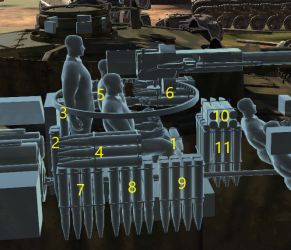
| Full ammo |
1st rack empty |
2nd rack empty |
3rd rack empty |
4th rack empty |
5th rack empty |
6th rack empty |
|---|---|---|---|---|---|---|
| 87 | 84 (+3) | 82 (+5) | 80 (+7) | 72 (+15) | 63 (+24) | 54 (+33) |
| 7th rack empty |
8th rack empty |
9th rack empty |
10th rack empty |
11th rack empty |
Visual discrepancy |
|
| 46 (+41) | 38 (+49) | 30 (+57) | 24 (+63) | 1 (+86) | No |
Notes:
- Racks are modeled by sets of 2 and disappear after both shells in the set having been shot or loaded.
- Sides empty: 30 (+57) shells.
Machine guns
| 7.92 mm MG34 | ||||
|---|---|---|---|---|
| Mount | Capacity (Belt) | Fire rate | Vertical | Horizontal |
| Coaxial | 3,150 (150) | 900 | N/A | N/A |
| Pintle | 2,100 (150) | 900 | -10°/+20° | ±180° |
Usage in battles
The Panzer IV J suffers compared to its other variants due to its slow, manual turret traverse rate. This causes the Panzer IV J to lose flexibility in reacting to close encounters without turning the entire hull around. As such, it is recommended not to use the Panzer IV J as a front-line assaulter in combat.
Tactics-wise, the Panzer IV J is perfect for sniping and ambushes, where the slower turret traverse rate affects its combat performance less. Attack from a distance, especially while that enemy is focused on other allies in the team. Ambushes can also work in close-range events when watching corners, street intersections, and choke points, but be wary of any enemies trying to outmanoeuvre the Panzer IV J as it would require drastic action with the slow turret rate. Try not to engage the enemy in a straight-up front confrontation as most enemies would be able to easily cleave through the front armour and end the vehicle.
Although any tank of Rank III can destroy the Panzer IV J pretty quickly, the tanks that mostly need to avoided in open combat are IS-2, KV-2, SU-152, Tiger and Panther tanks.
Most of the heavy tanks that it will face include Tigers, the last of KV series, IS-1s, and even some IS-2s. Particularly IS-2s will be the toughest opponent, and can take out the Panzer IV with one hit. Avoid frontal confrontation at all cost. Instead try to be sneaky and attack them from the sides where they become vulnerable.
Pros and cons
Pros:
- The KwK40 L/48 cannon can penetrate most enemies at the BR at long range with above average muzzle velocity, making aiming a bit easier
- PzGr 40 (APCR) offers great penetration in case PzGr 39 (APCBC) fails against heavily armoured targets
- The transmission provides good acceleration
- Satisfactory off-road and on-road mobility
- Turrets have Schürzen (side skirts), which can offer some protection from HEAT or HE rounds
- 2 crew members in the hull often saves the vehicle from destruction when the turret is penetrated and everyone up there dies
Cons:
- Turret traverse is slow compared to medium tanks at this BR
- Side skirts (Schürzen) only protect the turret, no side side skirts on the hull
- Lacks gun mantlet armour
- Armour protection is poor, able to be penetrated by all the tanks it encounters even frontally and vulnerable to overpressure
- Unable to traverse fast in rough terrains
History
Development
The Pz.Kpfw. IV was designed and approved for production in 1936. Envisioned as a support tank, it was equipped with a 75 mm howitzer at its initial stages. MAN, Krupp, and Rheinmetall-Borsig worked on the development of the Panzer IV, with Krupp's model finalized as the basis of the Panzer IV, using a leaf-spring double-bogie system for its suspension. The main armament was the KwK 37 L/24 75 mm howitzer. The vehicle held a crew of five, the commander, gunner, loader, radio operator (and hull machine gunner), and driver. Though it looked symmetrical, the Panzer IV turret was actually offset to the left of the chassis center line a bit while the engine was also offset to the right, this was to allow the torque shaft to turn the turret. The offset also meant that more of the ammo is held on the right side of the tank in storage areas. Nevertheless, the Panzer IV, with about 8,553 units made from 1936 to the end of World War II in 1945, it remained as one of Germany's main battle tank of the war, despite newer replacements such as the Panther tank.
The Panzer IV started with only minimum armour, 14.5 mm on the Ausf. A. This was upgraded to 20 mm on the Ausf. C. As the war moves on to 1940, the 20 mm armour was deemed insufficient, so 30 mm extra steel plates were bolted or welded on on the Ausf. E variant, becoming a permanent feature as a single 50 mm plate on the Ausf. F. As the war moves to the Invasion of Barbarossa, the German tank forces were unprepared for the appearance of the Soviet T-34 and KV-1 tanks, which could shrug the 75 mm howitzer on the Panzer IV. An upgrade was done on the gun to mount the newer and better KwK40 L/43 cannon on the Ausf. F2, which balanced the disparity on tank firepower. The Panzer IV was upgraded again in 1942 to the Ausf. G with an extra 30 mm steel plate applied to the 50 mm glacis, bringing the armour to 80 mm thick, plus a newer KwK40 L/48 gun that was slightly more powerful. Then in 1943, the most produced variant Ausf. H was finalized with a single-piece 80 mm glacis plate, Zimmerit paste, and Schürzen side armour skirts.
Panzer IV Ausf. J
However many Panzer IV the German Army fielded, the war was not looking their way by 1944. The Allied had landed in France in part of Operation Overlord, and the Soviet offensive in Operation Bagration had costed the Wehrmacht lots of land, personnel, and materiel. To replace the decimated armoured forces, the Panzer IV was once again revised not to be better, but for a more easily produced vehicle, the end result was a retrograde from the Panzer IV Ausf. H, the Panzer IV Ausf. J. The Panzer IV Ausf. J had the electric turret traverse and its associated auxiliary engine removed for an auxiliary fuel tank (although a dual speed hand-traverse was installed to compensate for this loss). The pistol and vision ports on the turret were removed, the engine radiator housing was simplified, a "Nahverteidigungswaffe" device was added for self-defense device (firing smoke or high-explosive shells on its surrounding). The armour on the tank roof was increased, the return rollers were reduced from four to three, the Schürzen skirts were changed from solid plates to wire-meshes. All of these were made to increase productivity of the Panzer IV while keeping combat survivability high.
Despite these features, the Panzer IV has already met its maximum limit. An attempt to mount the Schmalturm found on the Panther Ausf. F failed and only further proved this point. The Ausf. J's new features did not increase its survivability, nor was it able to replace the combat losses suffered on the German Panzer forces.
15 Panzer IV Ausf. J were bought by Finland for about twice its production price. Ironically, they arrived too late to fight the Soviets and instead were used against the Germans during the Lapland War between Finland and Germany. After the war, around 130 Panzer IVs of various variants made it to Syria in the 1950s and 1960s. These Panzer IVs served the Syrians alongside T-34-85s, T-54s, and T-55s during the Six-Day War against Israel.
| Archive of the in-game description | |
|---|---|
|
The final serial modification to the Pz.Kpfw.IV medium tank. It was a simplified version that was designed to be as easy as possible to produce. For example, the tank had no backup engine for rotating the turret, so it had to be rotated manually using flywheels. A metal mesh was frequently used instead of screens. The tank was produced between June, 1944 and March, 1945. 1,700 tanks were released. | |
Media
- Skins
- Sights
- Videos
See also
Links to the articles on the War Thunder Wiki that you think will be useful for the reader, for example:
- reference to the series of the vehicles;
- links to approximate analogues of other nations and research trees.
External links
Paste links to sources and external resources, such as:
- topic on the official game forum;
- other literature.
| Germany medium tanks | |
|---|---|
| Pz.III | Pz.III B · Pz.III E · Pz.III F · Pz.III J · Pz.III J1 · Pz.III J1 TD · Pz.III L · Pz.III M · Pz.III N |
| Pz.IV | Pz.IV C · Pz.IV E · Pz.IV F1 · Pz.IV F2 · Pz.IV G · Pz.IV H · Pz.IV J · Pz.Bef.Wg.IV J |
| Pz.V | VK 3002 (M) · Panther A · Panther D · Panther F · Panther G · Ersatz M10 · Panther II |
| M48 upgrades | M48A2 G A2 · M48 Super |
| Leopard 1 | Leopard I · Leopard A1A1 · Leopard A1A1 (L/44) · Leopard 1A5 · C2A1 · Turm III |
| Leopard 2 | PT-16/T14 mod. · Leopard 2K · Leopard 2AV |
| Leopard 2A4 · Leopard 2 (PzBtl 123) · Leopard 2A4M · Leopard 2 PL · Leopard 2A5 · Leopard 2 PSO · Leopard 2A6 · Leopard 2A7V | |
| Trophies | ▀M4 748 (a) · ▀T 34 747 (r) |
| Other | Nb.Fz. · KPz-70 |
| USA | mKPz M47 G · M48A2 C |
| USSR | ◊T-72M1 |


